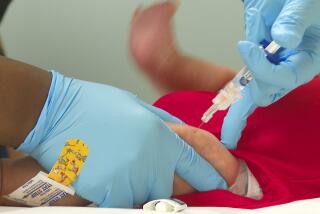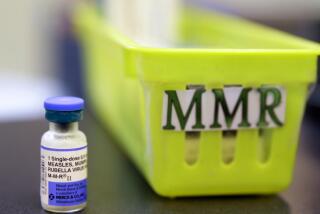Harvard-Westlake students were vaccinated. Dozens caught whooping cough anyway

Nearly 50 students at Harvard-Westlake School have been recently diagnosed with whooping cough, in an outbreak that has forced school officials to send students home at the first sign of illness.
But all of the sick students had been vaccinated against the disease, according to school officials. In fact, all 90 people who have recently come down with pertussis — the official name for whooping cough — in Los Angeles County this year had been immunized against it, according to county officials.
It turns out that four years after someone receives the booster shot in about the seventh grade, the vaccine’s protection nearly vanishes, endangering high schoolers such as those at Harvard-Westlake, said Dr. James Cherry, a UCLA expert on pediatric infectious diseases.
“It is not surprising at all,” Cherry said of the recent cases.
The outbreak is a real-life example of something that experts have been noticing since doctors switched to a new form of the pertussis vaccine in 1997: Immunity wanes quickly.
The pertussis outbreak raises questions about how to best administer a vaccine when its protection fades so quickly. People now in high school are one of the first generations to receive only the new, shorter-lived form of the vaccine, making them test cases for these problems.
These recent whooping cough cases also serve as a contrast to the measles outbreaks across the country, which are mostly among people who declined vaccinations. In those cases, immunization probably would have prevented most of the illnesses.
Whooping cough clusters
Los Angeles County officials announced last month that there were three clusters of whooping cough cases among adolescents across the county.
Forty-six students have been diagnosed with pertussis at Harvard-Westlake, where enrollment is about 1,600. Eighteen students there have not been vaccinated against pertussis, but none of them has caught the illness, school spokesman Ari Engelberg said.
Ten students at St. Anastasia Catholic School in Westchester also caught pertussis. All had been vaccinated, according to school officials.
Under California law, children must receive all of their doses of whooping cough vaccine to be allowed to attend school, unless they have a medical reason not to be vaccinated. By the time they turn 6, most children have received five doses of the diphtheria-tetanus-acellular-pertussis vaccine, or DTaP. Then they must get a booster before entering seventh grade.
The immunizations are concentrated in the earliest years of life because babies are the most likely to die from whooping cough, named for the sound people make when they’re gasping for air.
“Deaths virtually all occur in the first two months of life,” Cherry said.
But studies have found that immunity drops quickly after getting the shot. One study from Kaiser Permanente found that protection fell an average of 42% a year after the last childhood dose at about age 6.
The rapidly waning immunity is linked to the kind of vaccine children receive, experts say.
Before 1997, children received a form known as whole cell, which sometimes caused side effects, such as convulsions and severe fevers. So officials switched to the current acellular vaccine, which has fewer side effects but does not provide immunity for as long.
Even the middle school booster, intended to extend immunity, protects about 80% of people who receive it for about a year but mostly stops providing immunity after that, another Kaiser study found.
L.A. County public health officials said the recent cases may be focused in young adults because they are more susceptible to the illness because they received only the acellular vaccine.
“There is no increase in the current overall number of cases compared to past years, but the number of reported clusters has risen in 11- to 18-year-olds,” officials said in a statement to The Times. “Waning immunity is a well-recognized phenomenon … [and] seems to be the most plausible explanation for the recent clusters seen by the department.”
Some scientists have suggested that it would make more sense to administer the vaccine in a targeted fashion, such as before an outbreak or when one has just begun.
But Dr. Armand Dorian, chief medical officer at USC Verdugo Hills Hospital, said waiting to administer it when an outbreak has begun doesn’t make sense. At that point, antibiotics are needed.
“It’s too late to do brush clearance. You have to come in with a helicopter and douse a fire,” he said.
Dorian said that even though the vaccine’s immunity wanes, increasing coverage rates in the community would help prevent pertussis outbreaks.
In the 2017-2018 school year, 96% of kindergartners had all their doses of the pertussis vaccine and 98% of seventh-graders had received the booster, according to state data. Both of those percentages dropped slightly from the previous school year.
Doctors recommend that pregnant mothers get an additional dose of the vaccine so they can protect their newborns. But only 52% of new mothers in 2016 were vaccinated, according to a report from the California Department of Public Health.
If vaccination rates were higher, Dorian said, pertussis would not be able to enter a community in the first place. The bacteria is much more likely to spread among people who have not been vaccinated.
People who have been vaccinated and still get pertussis also contract a less severe form of the illness that is likely to be less contagious. So it’s possible that the recent outbreaks originated with someone who had not been immunized, even though the disease is now spreading among people who have been vaccinated, Dorian said.
“Once there’s a chink in the armor and that unvaccinated population grows, then the actual protection of the vaccination significantly drops, even for those who are vaccinated,” he said.
The real concern now is that a baby could contract whooping cough. Pertussis kills about 20 people in the United States each year, almost all of them infants. The last person to die from pertussis in California was a baby in San Bernardino County in 2018.
“It’s a cough, a whooping cough, which means it loves to spread,” Dorian said.
soumya.karlamangla@latimes.com
Twitter: @skarlamangla
More to Read
Sign up for Essential California
The most important California stories and recommendations in your inbox every morning.
You may occasionally receive promotional content from the Los Angeles Times.










